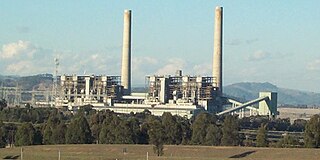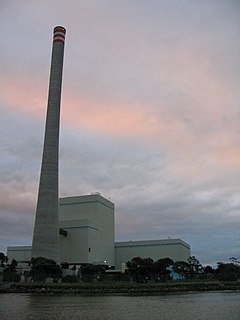Related Research Articles

Electricity generation is the process of generating electric power from sources of primary energy. For utilities in the electric power industry, it is the stage prior to its delivery to end users or its storage.

A power station, also referred to as a power plant and sometimes generating station or generating plant, is an industrial facility for the generation of electric power. Power stations are generally connected to an electrical grid.

A combined cycle power plant is an assembly of heat engines that work in tandem from the same source of heat, converting it into mechanical energy. On land, when used to make electricity the most common type is called a combined cycle gas turbine (CCGT) plant. The same principle is also used for marine propulsion, where it is called a combined gas and steam (COGAS) plant. Combining two or more thermodynamic cycles improves overall efficiency, which reduces fuel costs.

A fossil fuel power station is a thermal power station which burns a fossil fuel, such as coal or natural gas, to produce electricity. Fossil fuel power stations have machinery to convert the heat energy of combustion into mechanical energy, which then operates an electrical generator. The prime mover may be a steam turbine, a gas turbine or, in small plants, a reciprocating gas engine. All plants use the energy extracted from the expansion of a hot gas, either steam or combustion gases. Although different energy conversion methods exist, all thermal power station conversion methods have their efficiency limited by the Carnot efficiency and therefore produce waste heat.

The Richard L. Hearn Generating Station is a decommissioned electrical generating station in Toronto, Ontario, Canada. The plant was originally fired by coal, but later converted to burn natural gas. The plant has been described as "Pharaonic in scale", and encompasses 650 thousand cubic metres of space—large enough to fit 12 Parthenons inside.

Liddell Power Station is a coal-fired thermal power station with four 500 megawatts (670,000 hp) GEC steam driven turbine alternators for a combined electrical capacity of 2,000 megawatts (2,700,000 hp).

Wind power is one of the main renewable energy sources in Australia and contributed 10% of electricity supplied in 2020, with 37.5% total renewable energy supply. Australia has greatly distinguished conditions for harvesting wind power. Abundant wind resources may be located close to residential areas in the southern parts of the country and on the slopes of the Great Dividing Range in the east.

AGL Energy Ltd is an Australian listed public company involved in both the generation and retailing of electricity and gas for residential and commercial use. AGL is Australia's largest electricity generator, and the nation's largest carbon emitter. In 2014, the company had an operated generation capacity of 10,984 MW. The company emitted 42,227,180 Total Scope 1 Emissions in 2019-20 and 40,209,034 t CO2-e in 2020–21. AGL is also a significant investor, owner, and operator, of renewable energy assets.

The Newport Power Station was a complex of power stations located on the west bank of the Yarra River, approximately 6 km south-west of Melbourne, Victoria, Australia, in the suburb of Newport. Newport A, B, and C were coal-fired plants which operated at the site between 1919 and the 1980s, and were claimed to be the largest power station in the southern hemisphere in 1953 with 42 boilers and 14 turbo-alternators producing 327 megawatts (439,000 hp).

Tallawarra Power Station is a 435-megawatt (583,000 hp) combined cycle natural gas power station in the city of Wollongong, New South Wales, Australia. Owned and operated by EnergyAustralia, the station is the first of its type in New South Wales and produces electricity for the state during periods of high demand. It is located on the western shore of Lake Illawarra in the suburb of Yallah.

The Littlebrook Power Station were a series of four oil and coal-fired power stations situated on the south bank of the River Thames, next to the Queen Elizabeth 2 Bridge and the Dartford Tunnel in Dartford, Kent. The final power station, Littlebrook D, ceased operating in March 2015, and has now been demolished.

The Gould Street Generating Station was a former 100 MW electric generating plant operated by Exelon that was located on Gould Street in south Baltimore, Maryland, USA. The plant was adjacent to an elevated section of freeway I-95 and was south of the Riverside neighborhood and west of the Locust Point neighborhood of Baltimore. The plant site, located on the shore of the Middle Branch of the Patapsco River, was used for the generation of electric power for over one hundred years before being shut down on June 1, 2019. The site was purchased by Greenspring Realty Partners, Inc. for $3.1 million in December 2019. Demolition began in October 2020. The original brick buildings, the large storage tanks behind them, and other minor structures on the southwest portion of the property were demolished as of March 2021, but as of April 2022 the larger steel building to the northeast on the property remains. A large portion of the property was acquired by Weller Development in July 2021 and the future of the remaining structure and the property is not known.
Tamar Valley Power Station is a $230 million natural gas-fired power station located in Bell Bay in the Tamar Valley, Tasmania. It is owned by Hydro Tasmania, and is immediately adjacent to the decommissioned Bell Bay Power Station, which is also owned by Hydro Tasmania.

Infigen Energy (Infigen), operating under this name since 29 April 2009, is a developer, owner and operator of renewable energy generation assets in Australia. Infigen's wind farm portfolio has an installed capacity of 557 MW. Most of Infigen's assets generate electricity from renewable sources and are eligible to sell Large-scale Generation Certificates (LGCs) under the mandatory Renewable Energy Target scheme, which operates in Australia under the Renewable Energy (Electricity) Act 2000. Since 2020, Infigen Energy has been a subsidiary of Iberdrola.
Brighton Beach Generating Station is a natural gas fired combined cycle fossil fuel power station in the Brighton Beach neighbourhood of Windsor, Ontario, Canada owned by the Atura Power subsidiary of Ontario Power Generation. The electricity generated is under the control and marketing lead of Coral Energy Canada Inc. Gas for the plant is supplied by Union Gas, and cooling water is drawn from the Detroit River.
The Lincoln Gap Wind Farm is a wind farm in the vicinity of Lincoln Gap on northeastern Eyre Peninsula in South Australia, Australia. It consists of 59 wind turbines and generates a total of 212 MW of electricity. Construction began in late 2017 and was initially expected to be commissioned in late 2018. Construction was delayed in July 2018 when unexploded ordnance was discovered on the site, left from historic military testing. The site is not far from the Cultana Training Area.
Temporary Generation North and its smaller sibling Temporary Generation South were gas turbine power stations in South Australia. They were bought by the Government of South Australia in 2017 as a response to the 2016 South Australian blackout and load-shedding in February 2017.
Temporary Generation South and its larger sibling Temporary Generation North were gas turbine power stations in South Australia. They were bought by the Government of South Australia in 2017 as a response to the 2016 South Australian blackout and load-shedding in February 2017.
The Snapper Point Power Station is a gas turbine power station under development at Outer Harbor, South Australia, beside the older Pelican Point Power Station.
References
- ↑ "Shareholders". Nexif Energy. Retrieved 4 October 2019.
- ↑ "Nexif Energy Projects". Nexif Energy. Retrieved 4 October 2019.
- ↑ Siebert, Bension (29 August 2019). "Leasing out state-owned diesel generators will push prices down: expert". InDaily . Retrieved 30 August 2019.
- ↑ "NEXIF ENERGY TO PROVIDE 154MW OF RELIABLE GAS GENERATION TO THE SOUTH AUSTRALIAN POWER GRID". Nexif Energy. 28 August 2019. Retrieved 30 August 2019.